I.10.1 Pompeii. Workshop, and dwelling house. Excavated 1926 and 1932.

I.10.1
Pompeii, in centre, I.10.2 and 3, on right. December 2018.
Looking
south at junction of Vicolo del Menandro, on right, with Vicolo di
Paquius Proculus (on left). Photo courtesy of Aude Durand.

I.10.1 Pompeii, in centre, I.10.2 and 3, on right of centre. November 2024.
Looking west along south side of Vicolo del Menandro. Photo courtesy of Annette Haug.

I.10.1 Pompeii, on right. May 2017.
Looking south-west towards upper floor, with reconstructed balcony. Photo courtesy of Buzz Ferebee.

I.10.1 Pompeii, on right. April 2017.
Looking south in Vicolo del Menandro, towards fountain at junction
with Vicolo di Paquius Proculus (on left). Photo courtesy of Adrian Hielscher.

I.10.1 Pompeii. 1934. Plan of house and workshop. See Notizie
degli Scavi di Antichità, 1934, p. 266.
For details of “finds” from this house,
See Allison, P.M. (2006). The Insula of the Menander at Pompeii: Vol. III The finds, Clarendon Press, Oxford, (p.41-47, & p.289).
See Online companion with the finds and photographs
from I.10.1

I.10.1, Pompeii. November 2024.
West side of entrance doorway with identification number-plate. Photo courtesy of Annette Haug.

I.10.1 Pompeii. April 2017. Identification
number-plate. Photo courtesy of Adrian Hielscher.

I.10.1 (centre) and I.10.2 Pompeii. April 2017. Looking towards entrance doorways. Photo courtesy of Adrian Hielscher.

I.10.1 Pompeii. December 2005. Entrance.

I.10.1 Pompeii. December 2006. Entrance.

I.10.1 Pompeii. April 2017. Detail from east
side of entrance doorway. Photo courtesy of Adrian Hielscher.

I.10.1, Pompeii. November 2024. Looking south across atrium, from entrance doorway. Photo courtesy of Annette Haug.

I.10.1 Pompeii. April 2019.
Looking south across atrium, from entrance doorway. Photo courtesy of Rick Bauer.


Looking
across atrium towards south wall of room 3, tablinum, from entrance doorway.
Photo courtesy of Adrian Hielscher.

I.10.1
Pompeii. April 2017. Detail of south wall of tablinum, room 3. Photo courtesy of
Adrian Hielscher.

I.10.1 Pompeii. December 2004. Looking south across atrium, from entrance.
At the south end, on the left is a doorway to a cubiculum. On the right is the small, uncovered courtyard, kitchen and latrine.

I.10.1 Pompeii. December 2018.
Looking south-west across atrium. On the right, is the doorway to the small, uncovered courtyard, kitchen and latrine.
Photo
courtesy of Aude Durand.

I.10.1 Pompeii. 1934. Looking south-west across atrium. On the right, is the small, uncovered courtyard, kitchen and latrine.
See Notizie degli Scavi di Antichità, 1934, p.267 (fig.2).

I.10.1, Pompeii. November 2024.
Looking south along east wall of atrium with doorway to oecus and steps to upper floor, on left. Photo courtesy of Annette Haug.

I.10.1 Pompeii. December 2018.
Looking towards east wall of atrium with doorway to oecus
and steps to upper floor, on left. On the right would be a doorway to a
cubiculum.
Photo courtesy of Aude Durand.

Looking
towards doorway to oecus, and steps to upper floor against east wall. Photo
courtesy of Adrian Hielscher.

I.10.1 Pompeii. December 2006. East wall of atrium with doorway to oecus and steps to upper floor.
The first three steps were in masonry, the remaining in wood resting on the short landing.
On the upper floor, the small area was made up of two rooms on the corner.
The decoration of the two rooms, both illuminated by windows onto the roadway, was of the simplest type of the fourth style, with a background of purple/peacock blue and yellow, separated by black bands.
See Notizie degli Scavi di Antichità, 1934,
p.270.

I.10.1 Pompeii. December 2018.
Looking
towards north wall of atrium, and steps to upper floor. Photo courtesy of Aude
Durand.

I.10.1 Pompeii. April
2017. Looking
towards east wall of atrium with painted decoration. Photo courtesy of Adrian
Hielscher.

I.10.1 Pompeii. December 2006. Looking across atrium towards tablinum.
On the left, (east) of the tablinum is a small room, probably a cubiculum.

I.10.1 Pompeii. December 2006. West wall of atrium.
On the left of the photo, is the light from the window and doorway leading into the area of the room numbered as 5 in Notizie degli Scavi.
This is the uncovered courtyard, kitchen and latrine, (see detailed photos, below.)

I.10.1 Pompeii. April 2017. Looking along west wall of entrance
room, from entrance doorway. Photo courtesy of Adrian Hielscher.

I.10.1 Pompeii. April 2017.
Detail of painted decoration plaster on west wall. Photo courtesy of
Adrian Hielscher.

I.10.1 Pompeii. April 2017. Detail of zoccolo (dado) on west wall.
Photo courtesy of Adrian Hielscher.

I.10.1 Pompeii. December 2006. Looking along north wall of atrium from entrance doorway.

Looking
east from entrance doorway, into latrine. Photo courtesy of Adrian Hielscher.

I.10.1 Pompeii. July 2008. Looking east into latrine. Photo courtesy of Barry Hobson.


According to Olga Elia -
La scala era conservata per tre gradini ed un
pianerottolo a 1.15m dal suolo, e quivi sulla parete era dipinto un quadro di
Larario (0.55m x 0.40m) in cattivo stato di conservazione. Nella parte
conservata dei quadri si riconoscono, al centro, la figura del Genio coperta di
toga listata e velata, con il corno dell’Abbondanza nella sinistra; a destra
quella del Lare, avente nello mano abbassata una coppa e nella sinistra
sollevata un rhyton; ancora a destra, nell’estrema parte del quadro, si
osserva. Nella parte superiore pendono i lembi di un grande festone.
(The staircase is preserved for three steps and with a landing at 1.15 m from the ground, and here on the wall was painted a lararium picture (0.55 m x 0.40 m) in a poor state of preservation. In the preserved part of the paintings one recognizes, in the centre, the figure of the Genius covered with a toga, with the Horn of Abundance in the left hand; to the right that of the Lar, having a cup in his lowered hand and a drinking horn raised in his left hand; still on the right, in the extreme part of the picture, there is a large lit torch of conical form. In the upper part hang the flaps of a large garland.)
See Notizie degli Scavi
di Antichità, 1934, (p.265-6)

I.10.1 Pompeii. December 2006. Looking along north wall of
atrium. Site of Lararium.
See Fröhlich, T.,
1991, Lararien und Fassadenbilder in den
Vesuvstädten. Mainz: von
Zabern. (L12: p.254).

I.10.1 Pompeii. 1934. Small, uncovered area (No. 5) at the side of the Tablinum.
South wall with niches and bust of Kore. West wall with entrance doorway to kitchen and latrine.
See Notizie degli Scavi di Antichità, 1934, p.
268-9, fig 3.
In the very small, uncovered area (No. 5) to the east (west) of the Tablinum, you will find the kitchen and the latrine: almost in front of the window, the large rim of a sunken dolium used as Puteal (see note 1), marks the mouth of the cistern.
(Note 1: The empty-space of the cistern tank had caused, due to the subsidence, the sinking and the consequent hollow/depression in ground of the floor.)
At the rear, resting on the west wall of the tiny courtyard, are, to the right, the bench of the hearth covered with cocciopesto and with the edges of tiles, with the usual discharge arch; a thin partition divides the kitchen from the latrine, consisting of the usual recess with the encasing for the horizontal plank of wood.
In the south wall, was a recognizable shrine the whole of which consisted of three completely rustic niches, of which the first was of little larger than the others, within the same wall and having a shelf of rustic plaster below, formed with a fascia and cornice: found in the first niche was, resting on the wall, a terracotta relief in the shape of the bust of Kore (Fig. 3). The third niche appeared to be cut by the dividing wall that was the east wall of the latrine.
Two low masonry vats covered with cocciopesto, delimited a very small area for the collection of rainwater which was conveyed into the tank below; here flowed the drippings from the roof, and resting here on the wall of the shrine, was found a group of tiles put there, of which three were perforated and with ridge tile.
Apart from this material, also found were a group of six terracotta vases/pots of various forms and sizes and numerous nails and iron handles belonging to the window closings.
See Notizie degli Scavi di Antichità, 1934, (p.268-9)
List of objects found (p.270)
Nella piccolissima
area scoperta (no.5) ad oriente del tablino, si trovano allogate la cucina e la
latrina: quasi davanti alla finestra il grosso orlo di un dolio infossato,
adoperato come puteale (note.1), contrassegna l’orifizio della cisterna.
(Note 1: il
vuoto della canna di cisterna ha provocato, a causa del cedimento, lo
sprofondarsi ed il conseguente infossamento del piano di calpestio
corrispondente.)
In fondo,
appoggiati alla parete ovest del minuscolo cortile, sono, a destra, il banco
del focolare ricoperto di cocciopesto e con i margini di tegole, col solito
archetto di scarico al disotto; un sottile tramezzo divide la cucina dalla
latrina, costituita dal solito recesso con le incassature per l’asse
orizzontale di legno.
Nella parete
sud, era un sacello riconoscibile nell’insieme di tre nicchiette completamente
rustiche, delle quali la prima era di poco piu grande delle precedenti,
ricavate entro lo stesso muro e aventi al disotto una mensola di intonaco
rustico costituita da fascia e cornice: nella prima nicchietta fu rinvenuto,
appoggiato al muro, un rilievo di terracotta della forma di un semicerchio
ellitico, col busto di Kore (fig.3). La terza nicchietta appare tagliato dal
muro divisorio che costituisce la parete orientale della latrina.
Due bassi
pulvini di fabbrica, rivestiti di cocciopesto, delimitano una piccolissima
superficie scoperta per la raccolta delle piovane che erano convogliate nella
cisterna sottostante; qui versava infatti lo stillicidio dei tetti e qui,
appoggiato al muro del sacello, fu raccolto un gruppo di tegole ivi depositate,
di cui tre forate e con comignolo.
Oltre questo
materiale era un gruppo di sei vasi di terracotta, di varia forms e dimensione
e ancora numerosi chiodi e maniglie di ferro appartenenti alla chiusura della
finestra.
Ved. Notizie
degli Scavi di Antichità, 1934, (p.268-9)
Elenco degli
oggetti trovati, Notizie degli Scavi di Antichità, 1934, (p.270).

I.10.1 Pompeii. December 2018. Looking towards south wall of the small,
uncovered area (5). Photo courtesy of Aude Durand.

I.10.1 Pompeii. December 2018.
Two
of the niches in the south wall. Photo courtesy of Aude Durand.

I.10.1 Pompeii. December 2018.
Detail of the larger niche from south wall.
Photo courtesy of Aude Durand.



I.10.1
Pompeii. December 2018. Looking towards south-west corner. Photo courtesy of
Aude Durand.

I.10.1 Pompeii. December 2018. Looking towards south wall and
south-west corner, on right.
Photo courtesy of Aude Durand.
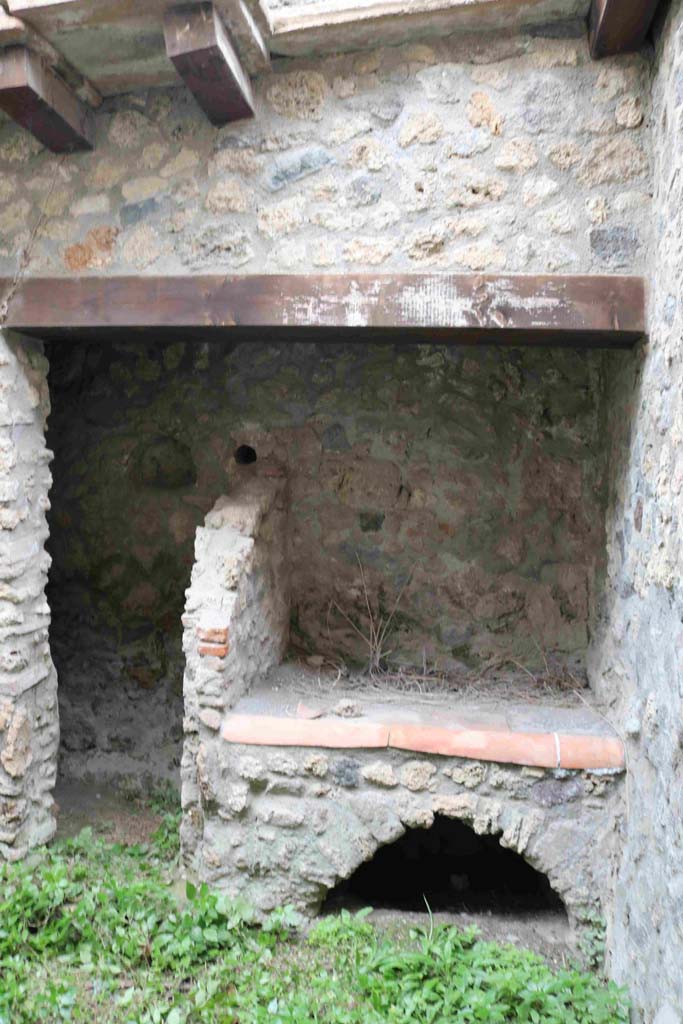
I.10.1
Pompeii. December 2018. Moss covered rock/stone/structure near the south-west
corner. Photo courtesy of Aude Durand.

I.10.1
Pompeii. December 2018. Moss covered rock/stone/structure near the south-west
corner. Photo courtesy of Aude Durand.
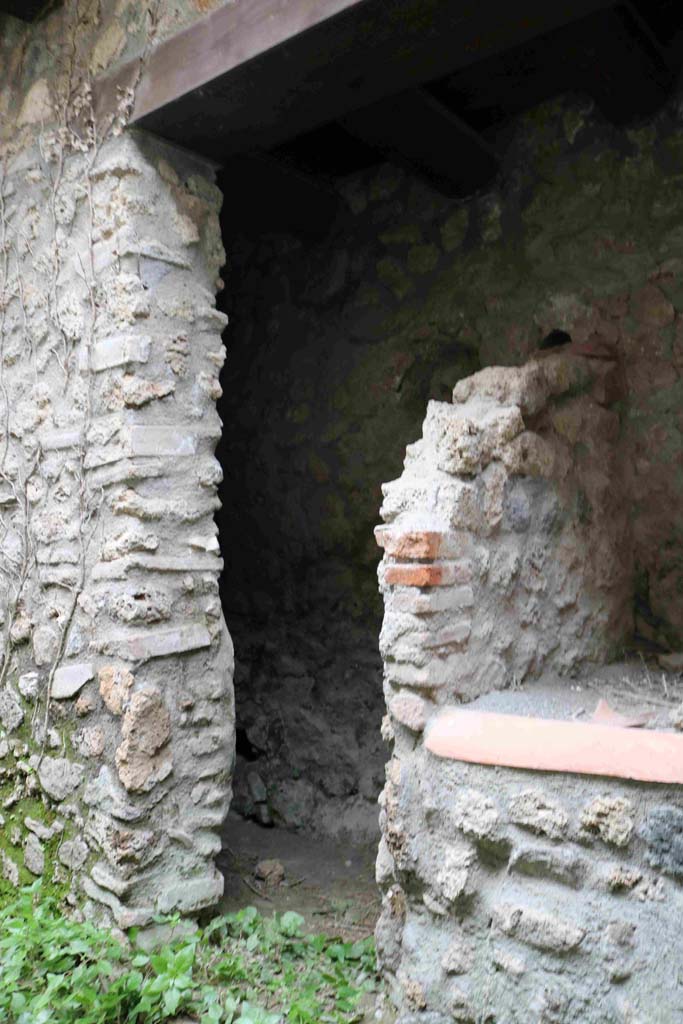
I.10.1 Pompeii. December 2018. South-west corner. Photo courtesy
of Aude Durand.

I.10.1 Pompeii. December 2018.
Detail of stonework in south-west corner. Photo
courtesy of Aude Durand.

I.10.1 Pompeii. December 2018. West wall of
small, uncovered area, with large doorway to kitchen area. Photo courtesy of
Aude Durand.

I.10.1 Pompeii. December 2018. Hearth in kitchen area. Photo
courtesy of Aude Durand.

I.10.1 Pompeii. December 2018. Niche in west wall of kitchen area.
Photo courtesy of Aude Durand.

I.10.1 Pompeii. December 2018.
Looking through doorway towards west wall
of latrine area, with niche. Photo courtesy of Aude Durand.

I.10.1 Pompeii. December 2018.
Looking south towards two niches on wall of
uncovered area, and third niche on south wall of latrine. Photo courtesy of
Aude Durand.

I.10.1
Pompeii. December 2018.
South
wall, with niche above latrine. Photo courtesy of Aude Durand.

I.10.1 Pompeii. December 2018. South wall of latrine with niche.
Photo courtesy of Aude Durand.
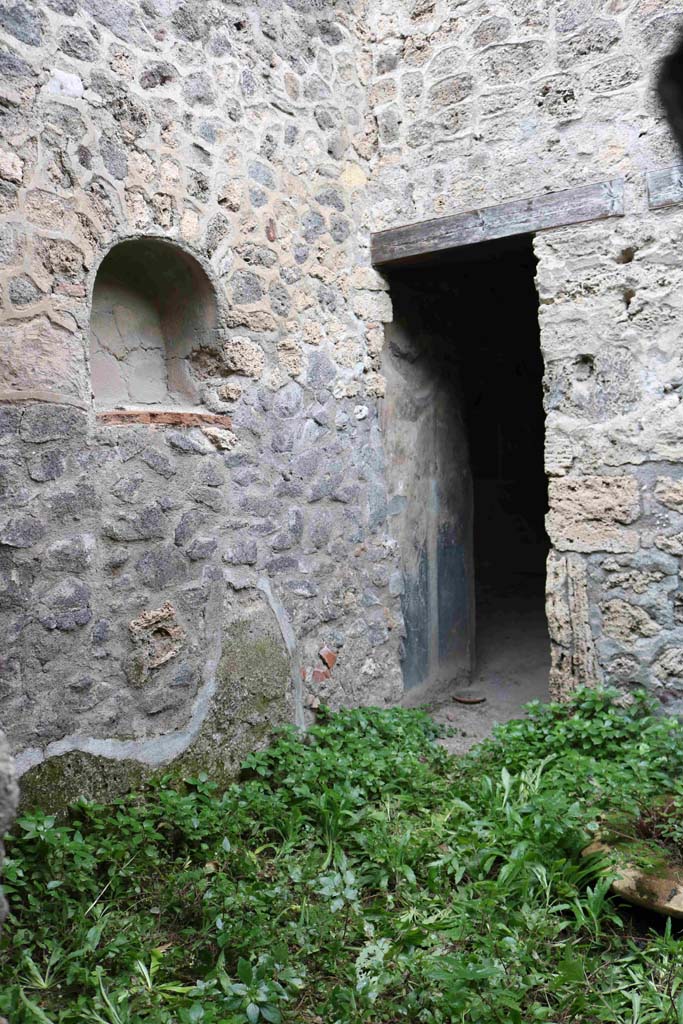

I.10.1 Pompeii. December 2018.
Detail of niche divided from its two other
niches, by the building of the wall of the latrine.
Photo courtesy of Aude Durand.

I.10.1 Pompeii. December 2018. South wall of latrine, below niche.
Photo courtesy of Aude Durand.
According to NdS, all three niches were
found with a shelf of rustic plaster below, formed with a fascia and cornice.
See Notizie
degli Scavi di Antichità, 1934, p. 268-9, fig 3 above.
On the south wall of the latrine, it has survived. In the open
uncovered area beneath the two niches, it has disappeared.

I.10.1 Pompeii. December 2018.
Looking
towards hearth in kitchen area, and niche set in north wall of small, uncovered
area (5). Photo courtesy of Aude Durand.

I.10.1
Pompeii. December 2018. Niche set in north wall of small, uncovered area (5).
Photo courtesy of Aude Durand.

I.10.1 Pompeii. December 2018.
North-east corner of small, uncovered area (5), with doorway to
tablinum/atrium. Photo courtesy of Aude Durand.
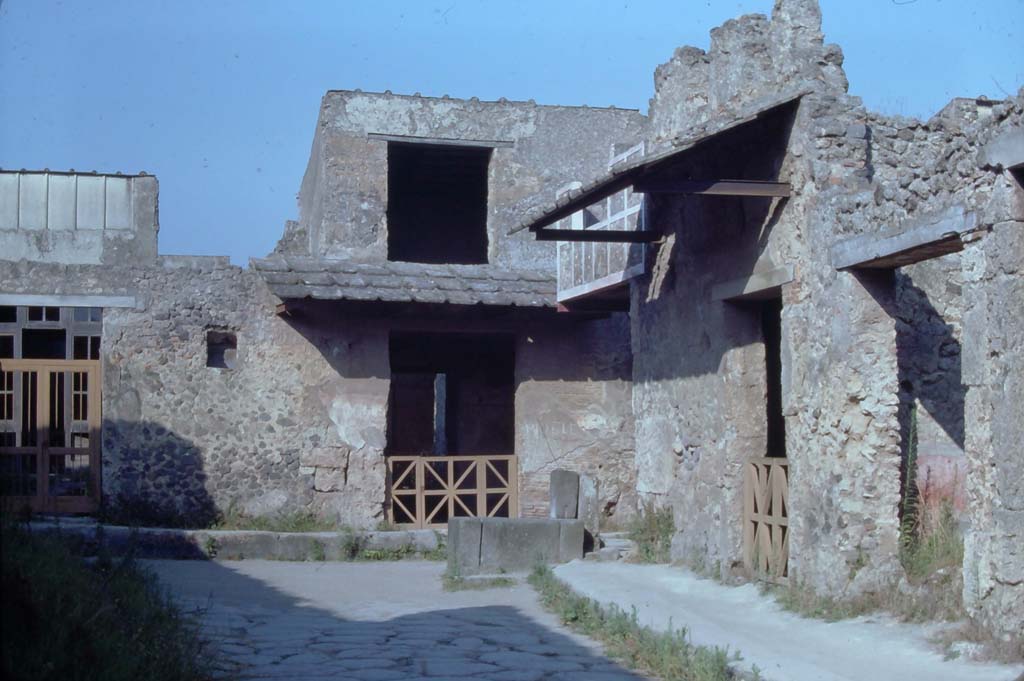
I.10.1 Pompeii. December 2005. Upper floor, with reconstructed balcony. Looking south.
![I.10.1 Pompeii. December 2006.
Possible site of Compitum identified as being near the fountain.
See Eschebach, L., 1993. Gebäudeverzeichnis und Stadtplan der antiken Stadt Pompeji. Köln: Böhlau. (p.51)
The photos on page 119 of Titulorum Pictorum Pompeianorum do not show any sign of a street shrine in this location.
However, there is a note that says originally the photos were ascribed to II.2.1-5.
At II.2.1 there was a street shrine, so perhaps that is where the confusion has arisen from.
See Varone, A. and Stefani, G., 2009. Titulorum Pictorum Pompeianorum, Rome: L’erma di Bretschneider, (p.119)
A graffito found, but no longer visible, above the remaining plaster on the exterior east wall, read:
Helvium
Sabinum aed(ilem) o(ro) v(os) f(aciatis) [CIL IV 7336]
See Epigraphik-Datenbank Clauss/Slaby (See www.manfredclauss.de)](1%2010%2001_files/image079.jpg)
I.10.1 Pompeii. December 2006. Possible site of Compitum identified as being near the fountain.
See Eschebach, L., 1993. Gebäudeverzeichnis und Stadtplan der antiken Stadt Pompeji. Köln: Böhlau. (p.51)
However, there is a note that says originally the photos were ascribed to II.2.1-5.
At II.2.1 there was a street shrine, so perhaps that is where the confusion has arisen from.
See Varone, A. and Stefani, G., 2009. Titulorum Pictorum
Pompeianorum, Rome:
L’erma di Bretschneider, (p.119)
A graffito found, but no longer visible, above the remaining plaster on the exterior east wall, read:
Helvium
Sabinum aed(ilem)
o(ro) v(os) f(aciatis)
[CIL IV 7336]
See Epigraphik-Datenbank Clauss/Slaby (See www.manfredclauss.de)
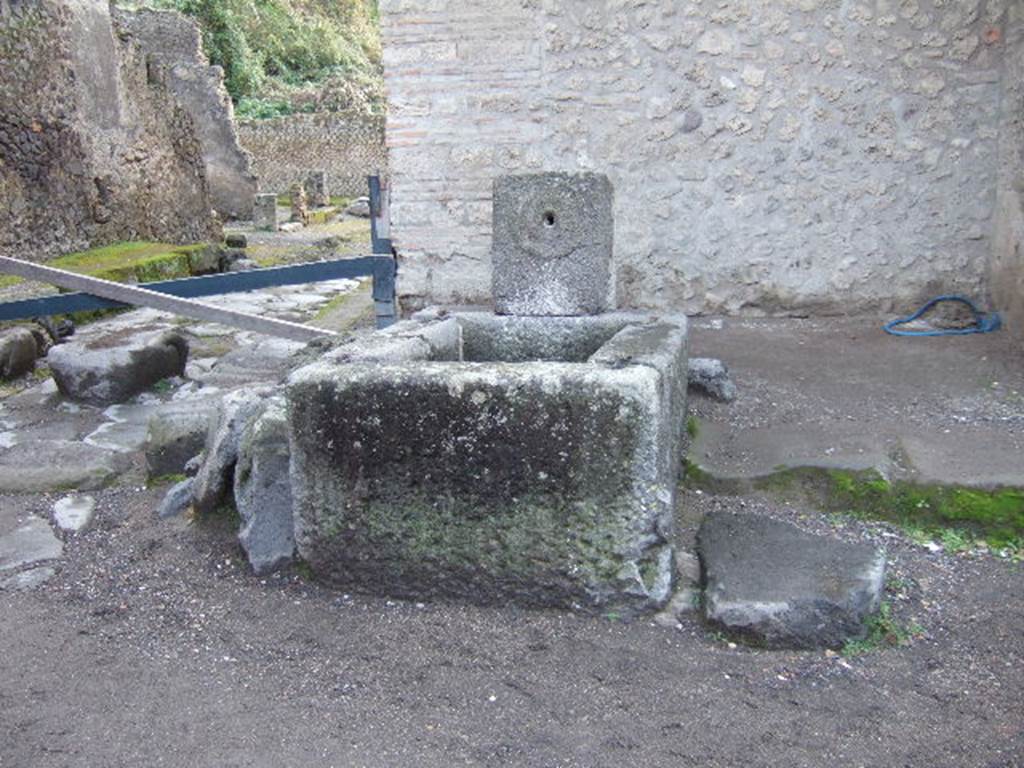
Fountain at I.10.1, Pompeii. December 2005. Looking south.

Vicolo del Menandro, Pompeii. August 1976. Looking east to end of the Vicolo with fountain at its junction with Vicolo di Paquius Proculus.
On the left and centre are I.7.19 and I.7.18. On
the right is I.10.1 and I.10.2.
Photo courtesy of Rick Bauer, from Dr George Fay’s slides
collection.